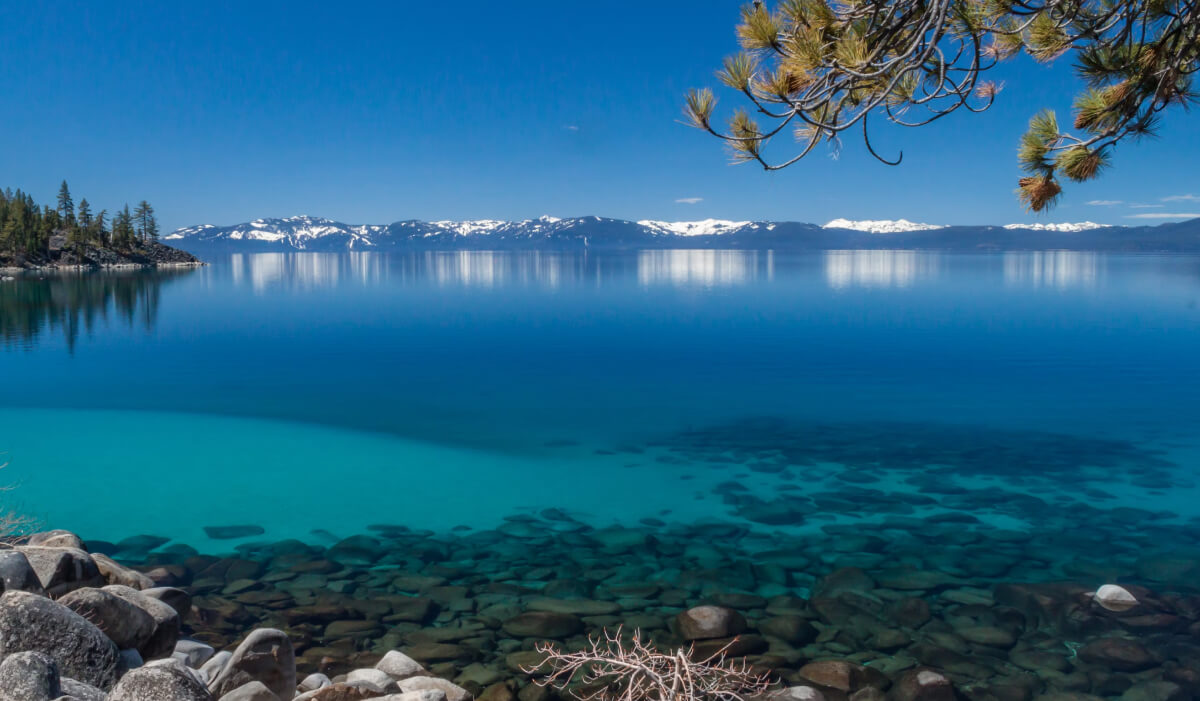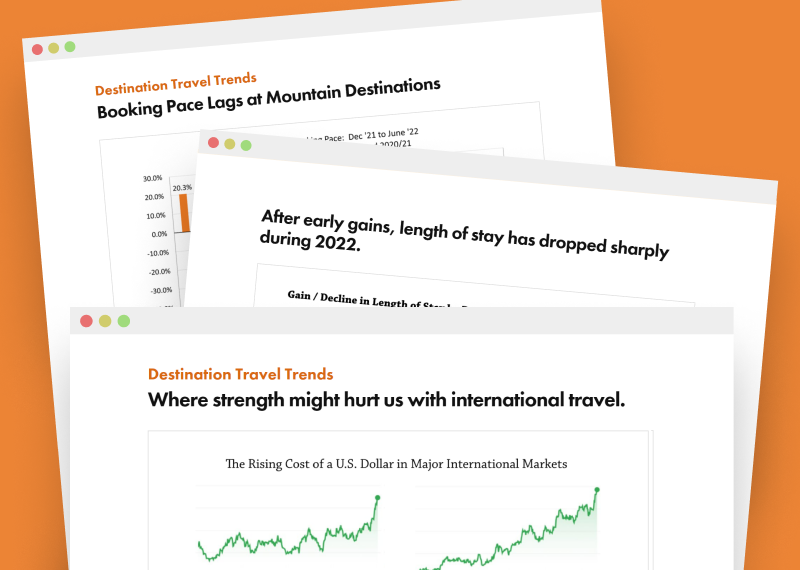

 Stacey Mullen
Stacey Mullen
Sep 14, 2023
While snowfall dominated the narrative for mountain destinations last winter, the ebbs and flows of economic news and dynamics have been writing the script for the past few months. According to the most recent monthly Market Briefing released by DestiMetrics,* the Business Intelligence division of Inntopia, after an exceptional winter season, summer bookings and occupancy were looking soft six months ago. But mostly positive market and labor news that was supported by rising consumer confidence over the summer helped mountain lodging properties, through strategic rate management, to claw back lost ground. With two months to go before the season closes, the summer of 2023 will likely finish down slightly from last year—but will still come very close to meeting the revenue record set last summer.
August results were down—but not out
In a year-over-year comparison to last August, actual occupancy was down 2.2 percent for the month while the Average Daily Rate (ADR) slipped 0.4 percent and the decline in both categories led to a moderate 2.6 percent decrease in revenue for the month. When compared to the pre-pandemic August of 2019, occupancy this year was down a notable 12.1 percent but with daily rates that were up 38.8 percent, lodging properties captured an aggregated 22 percent increase in revenues for the month compared to four years ago.
Strong summer rates are helping offset occupancy declines
As of Aug. 31, the combination of actual and on-the-books occupancy for the full summer from May through October is down 1.9 percent compared to last summer at this time—and a slight improvement from one month ago when it was down 2.2 percent. Although there are declines in all six months, September and October are showing the most notable drops. Once again, ADR is easing, but not erasing the revenue loss. Daily rates that are up 1.6 percent for the season—with the largest increases in May and June—are resulting in an 0.4 percent decline in aggregated summer revenues.
Looking back to the pre-pandemic summer of 2019 shows a markedly different scenario. Occupancy is down 7.7 percent for the full summer with all months but October declining. But with the ADR up a robust 41.9 percent from four years ago, the impact of lower occupancy was easily offset with properties posting a 30.9 percent gain in summer revenues as of Aug. 31.
“The peak summer months are now firmly in the books but the autumn months of September and October continue to show the most consistent growth in the past 12 years,” explained Tom Foley, senior vice president of Business Intelligence for Inntopia. “At the moment, we’re seeing that trend continue as August bookings for September arrivals are looking strong and with the right balance of rate management and consumer demand, occupancy and revenues could get even closer to last summer’s record levels.”
The economy—and consumer response
For only the third time in 2023, the Dow Jones Industrial Average (DJIA) declined from the previous month—down 2.36 percent, or 837.62 points during August. Markets varied considerably during the month with half of the trading days posting gains—and half posting losses. Investors did react positively to bank earnings that suggest the Federal Reserve Bank my pause on interest rate hikes. Good news about both employment and wages also appeared to buoy investors but concerns about a weakening Chinese economy, a significant drop in consumer confidence, and a slight uptick in inflation during August combined to dampen investor enthusiasm. Despite the waffling, the DJIA is up a strong 9.2 percent from August 2022.
After two months of growing consumer optimism, the Consumer Confidence Index (CCI) and the Consumer Sentiment Index (CSI) both reversed direction during August and retreated with the CCI dropping 6.9 percent while the CSI was a bit more resilient—dropping only 2.9 percent. A resumption of worries about inflation, particularly groceries and gasoline prices which both remained high, triggered the downturn in optimism after several months of positive perceptions.
Also changing direction in August, the national Unemployment Rate rose 0.3 percent during August from 3.5 to 3.8 percent with 187,000 new jobs added during the month. Additionally, new job numbers for both June and July were revised down and leading to a three-month average of 150,00 new jobs per month—dramatically lower than the average of 200,000 per month of the last two years and closer to the pre-pandemic average of 169,000. The report also indicated that wages were up an annualized 4.3 percent which was lower than expectations but enough to outpace inflation. And after lagging behind other sectors in recent months, the hospitality industry had an exceptionally good month by adding 40,000 new jobs.
Winter season coming into focus
Labor Day weekend and kids heading back-to-school shifts vacation planning to the winter season. As of Aug. 31, on-the-books occupancy for November through February is down a slight 1.2 percent compared to last year at this time with higher occupancy for November and December while January and February are both showing minor declines—less than three percent in both months. ADR continues its upward trajectory with an aggregated 4.5 percent increase over last year with growth in all months and January showing the greatest strength—up 8.5 percent over last year.
When compared to four years ago at this time, before the pandemic, occupancy is up 0.2 percent with healthy increases in both November and December. ADR for those four winter months is up a very strong 42.9 percent with gains in all months. When coupled with the higher occupancy, revenues for the period are up a robust 43.4 percent over four years ago at this time.
Still watching
*Average Daily Rate: after two months of year-over-year rate increase, summer ADR softened very slightly from July and indicates continued rate sensitivity for summer lodging—particularly since there was a considerable pullback early in the summer but mostly recovered during June.
*Booking Pace: compared to last year, bookings in August made for arrivals in the next six months declined 5.1 percent during August, only the second month that bookings declined in 2023 and marks the sharpest downturn in pace since September 2022. However, much of the decline can be attributed to strength last year rather than weakness this year.
*Performance by price tercile: lower-priced properties continued to struggle with ADR during August more than the higher-priced terciles. Properties with an ADR below $250 posted an 0.5 percent year-over-year dip in rate for arrivals in August through October. Units in the mid-price range from $251 to $400 also posted a scant 0.3 percent softening but picked up a small amount of occupancy. The highest tercile—lodging $400 per night and higher—experienced the biggest drop in year-over-year ADR since July but improved their occupancy which allowed them to actually improve their revenues during the month. Higher end properties were better able to adjust daily rates and as a result, preserve revenue.
“What started as a summer with extreme revenue and lodging demand challenges has achieved a remarkable comeback and is now trending to finish in a slightly down position from a year ago—a vast improvement from how things were shaping up back in February,” clarified Foley. “Looking ahead to winter bookings, we’re still seeing some rate sensitivity but some return to the rate strength we saw last year at this time,” he continued. “And even though winter occupancy is down slightly, a foundation of high-end bookings is already being established. As economic pressures ease a bit, the stage is set for a winter season that will, as always, be defined by snowfall,” he concluded.
Have a question? Just ask.

Tyler Maynard
SVP of Business Development
Ski / Golf / Destination Research
Schedule a Call with Tyler→

Doug Kellogg
Director of Business Development
Hospitality / Attractions
Schedule a Call with Doug→
If you're a current Inntopia customer, contact support directly for the quickest response →
Request Demo
A member of our team will get back to you ASAP to schedule a convenient time.



